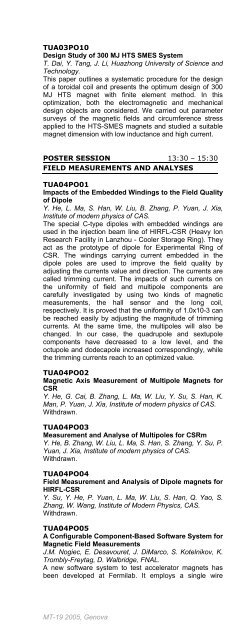Click here to download the abstract booklet in pdf format - MT19 - Infn
Click here to download the abstract booklet in pdf format - MT19 - Infn
Click here to download the abstract booklet in pdf format - MT19 - Infn
Create successful ePaper yourself
Turn your PDF publications into a flip-book with our unique Google optimized e-Paper software.
TUA03PO10<br />
Design Study of 300 MJ HTS SMES System<br />
T. Dai, Y. Tang, J. Li, Huazhong University of Science and<br />
Technology.<br />
This paper outl<strong>in</strong>es a systematic procedure for <strong>the</strong> design<br />
of a <strong>to</strong>roidal coil and presents <strong>the</strong> optimum design of 300<br />
MJ HTS magnet with f<strong>in</strong>ite element method. In this<br />
optimization, both <strong>the</strong> electromagnetic and mechanical<br />
design objects are considered. We carried out parameter<br />
surveys of <strong>the</strong> magnetic fields and circumference stress<br />
applied <strong>to</strong> <strong>the</strong> HTS-SMES magnets and studied a suitable<br />
magnet dimension with low <strong>in</strong>ductance and high current.<br />
POSTER SESSION 13:30 – 15:30<br />
FIELD MEASUREMENTS AND ANALYSES<br />
TUA04PO01<br />
Impacts of <strong>the</strong> Embedded W<strong>in</strong>d<strong>in</strong>gs <strong>to</strong> <strong>the</strong> Field Quality<br />
of Dipole<br />
Y. He, L. Ma, S. Han, W. Liu, B. Zhang, P. Yuan, J. Xia,<br />
Institute of modern physics of CAS.<br />
The special C-type dipoles with embedded w<strong>in</strong>d<strong>in</strong>gs are<br />
used <strong>in</strong> <strong>the</strong> <strong>in</strong>jection beam l<strong>in</strong>e of HIRFL-CSR (Heavy Ion<br />
Research Facility <strong>in</strong> Lanzhou - Cooler S<strong>to</strong>rage R<strong>in</strong>g). They<br />
act as <strong>the</strong> pro<strong>to</strong>type of dipole for Experimental R<strong>in</strong>g of<br />
CSR. The w<strong>in</strong>d<strong>in</strong>gs carry<strong>in</strong>g current embedded <strong>in</strong> <strong>the</strong><br />
dipole poles are used <strong>to</strong> improve <strong>the</strong> field quality by<br />
adjust<strong>in</strong>g <strong>the</strong> currents value and direction. The currents are<br />
called trimm<strong>in</strong>g current. The impacts of such currents on<br />
<strong>the</strong> uniformity of field and multipole components are<br />
carefully <strong>in</strong>vestigated by us<strong>in</strong>g two k<strong>in</strong>ds of magnetic<br />
measurements, <strong>the</strong> hall sensor and <strong>the</strong> long coil,<br />
respectively. It is proved that <strong>the</strong> uniformity of 1.0x10-3 can<br />
be reached easily by adjust<strong>in</strong>g <strong>the</strong> magnitude of trimm<strong>in</strong>g<br />
currents. At <strong>the</strong> same time, <strong>the</strong> multipoles will also be<br />
changed. In our case, <strong>the</strong> quadrupole and sextupole<br />
components have decreased <strong>to</strong> a low level, and <strong>the</strong><br />
octupole and dodecapole <strong>in</strong>creased correspond<strong>in</strong>gly, while<br />
<strong>the</strong> trimm<strong>in</strong>g currents reach <strong>to</strong> an optimized value.<br />
TUA04PO02<br />
Magnetic Axis Measurement of Multipole Magnets for<br />
CSR<br />
Y. He, G. Cai, B. Zhang, L. Ma, W. Liu, Y. Su, S. Han, K.<br />
Man, P. Yuan, J. Xia, Institute of modern physics of CAS.<br />
Withdrawn.<br />
TUA04PO03<br />
Measurement and Analyse of Multipoles for CSRm<br />
Y. He, B. Zhang, W. Liu, L. Ma, S. Han, S. Zhang, Y. Su, P.<br />
Yuan, J. Xia, Institute of modern physics of CAS.<br />
Withdrawn.<br />
TUA04PO04<br />
Field Measurement and Analysis of Dipole magnets for<br />
HIRFL-CSR<br />
Y. Su, Y. He, P. Yuan, L. Ma, W. Liu, S. Han, Q. Yao, S.<br />
Zhang, W. Wang, Institute of Modern Physics, CAS.<br />
Withdrawn.<br />
TUA04PO05<br />
A Configurable Component-Based Software System for<br />
Magnetic Field Measurements<br />
J.M. Nogiec, E. Desavouret, J. DiMarco, S. Kotelnikov, K.<br />
Trombly-Freytag, D. Walbridge, FNAL.<br />
A new software system <strong>to</strong> test accelera<strong>to</strong>r magnets has<br />
been developed at Fermilab. It employs a s<strong>in</strong>gle wire<br />
measurement technique and is targeted at field angle and<br />
strength measurements. The software for <strong>the</strong> system is<br />
built on <strong>to</strong>p of a flexible component-based framework,<br />
which allows for easy reconfiguration and run-time<br />
modification. Various user <strong>in</strong>terface, data acquisition,<br />
analysis, and data persistence components can be<br />
configured <strong>to</strong> form different measurement systems that are<br />
tailored <strong>to</strong> specific requirements. The system can also be<br />
configured with various measurement sequences or tests,<br />
each of <strong>the</strong>m controlled by a dedicated script. It is capable<br />
of work<strong>in</strong>g <strong>in</strong>teractively as well as execut<strong>in</strong>g a pre-selected<br />
sequence of tests. Each test can be parameterized <strong>to</strong> fit<br />
<strong>the</strong> specific magnet type or test stand requirements. The<br />
system has been designed with portability <strong>in</strong> m<strong>in</strong>d and is<br />
capable of work<strong>in</strong>g on various platforms, such as L<strong>in</strong>ux,<br />
Solaris, and W<strong>in</strong>dows. It can be configured <strong>to</strong> use a local<br />
data acquisition subsystem or a remote data acquisition<br />
computer, such as a VME processor runn<strong>in</strong>g VxWorks. All<br />
hardware-oriented components have been developed with<br />
a simulation option that allows for runn<strong>in</strong>g and test<strong>in</strong>g<br />
measurements <strong>in</strong> <strong>the</strong> absence of data acquisition<br />
hardware.<br />
TUA04PO06<br />
Current distribution identification <strong>in</strong> PF-FSJS<br />
F. Bell<strong>in</strong>a, Università di Ud<strong>in</strong>e.<br />
The Poloidal Field Full-Size Jo<strong>in</strong>t Sample (PF-FSJS) was<br />
built and tested jo<strong>in</strong>tly by ENEA and CEA <strong>in</strong> 2002 at<br />
SULTAN facility, <strong>to</strong> test two different types of full-size NbTi<br />
multistrand cables, and <strong>to</strong> assess a possible design for <strong>the</strong><br />
ITER coil electrical jo<strong>in</strong>ts. The sample was equipped with<br />
many sensors, <strong>to</strong> measure <strong>the</strong>rmal-hydraulic and<br />
electromagnetic quantities. Among <strong>the</strong>m, a set of magnetic<br />
field measurements was taken by means of pick- up coils<br />
located as close as possible <strong>to</strong> <strong>the</strong> cable. These signals<br />
can be used <strong>to</strong> reconstruct <strong>the</strong> current distribution among<br />
<strong>the</strong> ma<strong>in</strong> cable bundles, so that some <strong>in</strong><strong>format</strong>ion can be<br />
obta<strong>in</strong>ed about both <strong>the</strong> current redistribution along <strong>the</strong><br />
cable and <strong>the</strong> effect of <strong>the</strong> non uniform electric contact<br />
between <strong>the</strong> cable bundles and <strong>the</strong> jo<strong>in</strong>t/term<strong>in</strong>ations. The<br />
most common procedure of current distribution<br />
reconstruction is based on <strong>the</strong> S<strong>in</strong>gular Value<br />
Decomposition (SVD), which has been applied <strong>to</strong> some<br />
o<strong>the</strong>r actual cases by several authors, us<strong>in</strong>g suitable<br />
techniques <strong>to</strong> m<strong>in</strong>imise <strong>the</strong> effect of <strong>the</strong> measurement<br />
errors. However, a number of unresolved questions are still<br />
present as regards <strong>the</strong> procedure overall accuracy which,<br />
<strong>in</strong> some cases, may jeopardise <strong>the</strong> reconstruction results.<br />
Start<strong>in</strong>g from its application <strong>to</strong> PF-FSJS, <strong>the</strong> paper<br />
presents a critical review of <strong>the</strong> SVD method, analys<strong>in</strong>g <strong>in</strong><br />
detail <strong>the</strong> procedure sensitivity, <strong>the</strong> effects of <strong>the</strong> s<strong>in</strong>gular<br />
values truncation and of <strong>the</strong> most usual geometrical<br />
approximations adopted <strong>in</strong> this types of analysis.<br />
TUA04PO07<br />
Analysis of <strong>the</strong> Magnetic Field <strong>in</strong> Magnetic Fluid<br />
Acceleration Sensor<br />
W. Yang, Q. Yang, H. Chen, S. Liu, J. Sun, W. Yan, Key<br />
Labora<strong>to</strong>ry of Electromagnetic Field and Electrical<br />
Apparatus Reliability of Hebei University of Technology.<br />
Magnetic fluid (MF) consists of ultraf<strong>in</strong>e particles of<br />
ferromagnetic substance dispersed steadily <strong>in</strong> solvent<br />
us<strong>in</strong>g an <strong>in</strong>terfacial active agent. It is a new function<br />
material and has both liquid and magnetic properties that<br />
make it be proper <strong>to</strong> develop many types of sensors. A<br />
simple and attractive application of magnetic fluid is an<br />
acceleration sensor which has good features compared <strong>to</strong><br />
some traditional ones. This paper presents a magnetic fluid<br />
acceleration sensor, whose design pr<strong>in</strong>ciple is given and<br />
MT-19 2005, Genova 62



